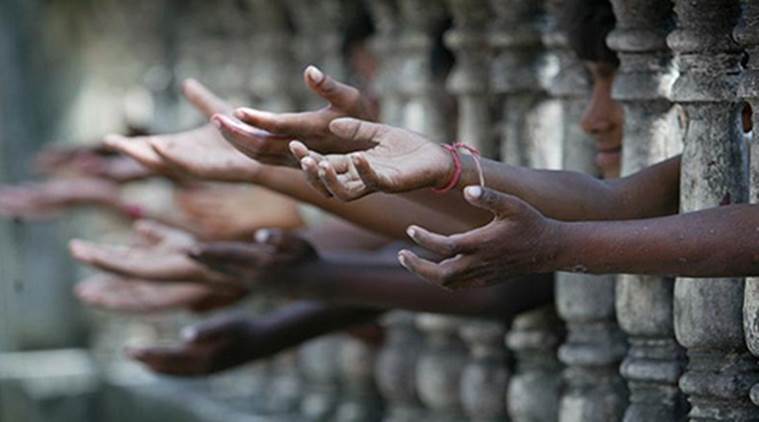Stay updated with the latest - Click here to follow us on Instagram
Malnutrition predominant risk factor for 68 per cent deaths in under-5 children in 2017: Report
This study provides a comprehensive account of the burden of child and maternal malnutrition in every state of India from 1990 to 2017.
 The state-specific findings in this report were published online in the Lancet Child Adolescent Health and released by ICMR today in New Delhi. (Representational Image)
The state-specific findings in this report were published online in the Lancet Child Adolescent Health and released by ICMR today in New Delhi. (Representational Image)
Malnutrition continues to be the underlying risk factor for the deaths of children under the age of five years in India and contributed to 68.2 per cent of such deaths in 2017. Of the 1.04 million under-5 deaths in 2017, at least 7,06,000 could be attributed to malnutrition, according to the first estimates of the disease burden due to child and maternal malnutrition and trends of its indicators in each state from 1990 by the India State-Level Disease Burden Initiative. On the other hand, Child overweight is increasing in a subset of children at 5 per cent per year in India, reveal the findings.
This is a joint initiative of Indian Council of Medical Research, Public Health Foundation of India and Institute of Health Metrics and Evaluation in collaboration with the Ministry of Health and Family Welfare along with experts from over 100 institutions.
The state-specific findings in this report published online in the Lancet Child Adolescent Health and released by ICMR at Delhi on Wednesday indicate the effort needed in each state and this will be useful in tracking and motivating further progress, Prof Lalit Dandona, Director of India State-Level Disease Burden Initiative told The Indian Express.
This study provides a comprehensive account of the burden of child and maternal malnutrition in every state from 1990 to 2017 by using accessible data analysed in the unified Global Burden of Diseases, Injuries, and Risk Factors Study framework.
Researchers have also projected prevalence of malnutrition indicators for the states up to 2030 on the basis of the 1990-2017 trends for comparison with India National Nutrition Mission (NNM) 2022 and WHO and UNICEF 2030 targets.
According to the findings, if the trends continue, NNM 2022 and the WHO and UNICEF 2030 targets will not be achieved in most states — except for the targets of low birthweight and stunting in a few states and exclusive breastfeeding in several, Dr R Hemalatha, Director of ICMR-National Institute of Nutrition at Hyderabad said. According to Dr Lalit Dandona, Director, India State-Level Disease Burden Initiative, Andhra Pradesh, Assam, Chhattisgarh, Himachal Pradesh, Jammu & Kashmir, Manipur, Odisha, Telangana, Tripura could meet the WHO/UNICEF breastfeeding targets, Goa, Kerala, Sikkim, Tamil Nadu could meet the NNM 2022 stunting targets and Kerala, Uttarakhand, West Bengal those for stunting set by WHO. Only Maharashtra and Sikkim would meet the low birth weight targets set by WHO.
However, child mortality attributable to malnutrition has dropped by two-thirds since 1990, the proportional contribution of malnutrition to disease burden in all ages together has
dropped by half since 1990. “While India has set ambitious targets for child nutrition indicators, the current paper published in The Lancet provides a reality check. Instead of calling this a warning, I would label it as a call for intensified action if we are serious about achieving the set targets,” says another key researcher, Dr Subodh Gupta from Mahatma Gandhi Institute of Medical Sciences at Wardha.
Prof Vinod K Paul, Member, NITI Aayog said, “The study findings are released at an opportune time when Government of India is intensifying its efforts to address the issue of malnutrition across the country. September is being observed as Poshan Maah with the aim of reaching every household with the message of nutrition. Focus on improving the overall nutritional status of girls and women during the preconception and pregnancy period, providing quality antenatal care will positively influence low birth weight indicators and extend the benefits to next generation,” he added.
Malnutrition was the leading risk factor in children younger than 5 years in every state in 2017. Low birth weight — less than 2500 g — is the largest contributor to child deaths in India, followed by child growth failure which include stunting, underweight, and wasting. The prevalence of low birthweight was 21 per cent in India in 2017, ranging from 9 per cent in Mizoram to 24 per cent in Uttar Pradesh. The annual rate of reduction was 1.1 per cent in India between 1990 and 2017, ranging from 3.8 per cent in Sikkim to 0.3 per cent in Delhi.
If low birthweight is a problem, then the prevalence of overweight in children at 12% in 2017 is also a matter of concern. It was the highest in the more developed states, but is rapidly increasing in all states of India.
The prevalence of child stunting was 39 per cent in India in 2017. This ranged from 21 per cent in Goa to 49 per cent in Uttar Pradesh. The annual rate of reduction was 2.6 per cent in India between 1990 and 2017, which varied from 4 per cent in Kerala to 1.2 per cent in Meghalaya. The study looked at how child malnutrition parameters have changes in Indian states and found that in traditionally laggard states like Uttar Pradesh, Madhya Pradesh, Assam and Rajasthan, the prevalence of low birth weight remains high even as the rate of change between 2010 and 2017 was the lowest. Child stunting was the highest in Uttar Pradesh, Jharkhand and Bihar and the rate of change the slowest.








